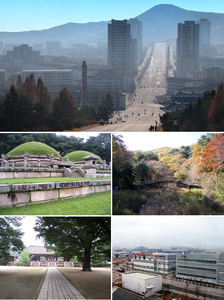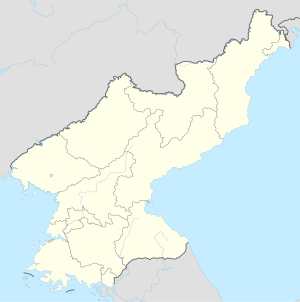Kaesŏng
| Kaesŏng | |||
|---|---|---|---|
| Korean alphabet : | 개성시 | ||
| Chinese characters : | 開 城市 | ||
| Revised Romanization : | Gaeseong-si | ||
| McCune-Reischauer : | Kaesŏng-si | ||
| Basic data | |||
| Province : | Hwanghae-pukto | ||
| Coordinates : | 37 ° 58 ' N , 126 ° 33' E | ||
| Residents: | 308,440 (as of 2008) | ||
| map | |||
|
|||
Kaesŏng is the fifth largest city in North Korea with 308,440 inhabitants. From the 10th to the end of the 14th century, it was the capital of the Korean kingdom of Goryeo with brief interruptions . It is an industrial city, transport hub and cultural center with universities, theaters and museums. Kaesŏng was a city under central government administration from 1955 to 2003. It has been part of Hwanghae-pukto Province since 2003 .
geography
Geographical location
The city is located in the province of Hwanghae-pukto , an average of 70 meters above sea level . The city center is only ten kilometers west of Panmunjeom , and therefore from the border with South Korea . It is surrounded by the Songak (489 meters) and Pongmyong mountains. The geographic coordinates are 37.97 degrees north and 126.56 degrees east.
City structure
Until 2002 the city of Kaesŏng was divided as follows:
- Kaesŏng-si (개성시, 開 城市)
- Changp'ung-gun (장풍군; 長 豊 郡)
- Kaep'ung-gun (개풍군; 開 豊 郡)
- P'anmun-gun (판문군; 板 門 郡)
In 2002, the district of P'anmun and part of the city of Kaesŏng were removed from the special administrative region and the Kaesŏng industrial area was established . In 2003, the remaining part of Kaesŏng City and Changp'ung and Kaep'ung Counties were joined to Hwanghae-pukto Province.
climate
Kaesŏng has essentially a temperate continental climate with four distinct seasons. The average annual temperature is 10.3 degrees Celsius. The annual precipitation of 1300 to 1400 millimeters on average falls mainly during the monsoons ( jangma ) in the period from June to August. The winter months are characterized by cold and drought. Typhoons occasionally hit the city in autumn . Spring and autumn are characterized by mild temperatures, changing winds and pleasant weather.
history
Historical overview
The city was selected as the capital of his empire in 918 by order of King Taejo (877–943), who founded the Goryeo empire and the Goryeo dynasty (918–1392) under the name of King Wang Geon . At that time it was called Songak and had around 800,000 inhabitants. In 960, the eleventh year of King Gwangjong's reign, the city was renamed Gaegyeong (Kaesŏng). While the capital of Silla was in the extreme southeast, Kaesŏng was then in the center of the empire.
In 1392 Yi Seong-gye founded the Joseon Dynasty (1392-1897) and moved the capital from Kaesŏng to Hanyang, today's Seoul . Kaesŏng was annexed to Gyeonggi-do and sank into a provincial town that only housed a fraction of its previous population.
With the incorporation of Korea into the Japanese Empire in 1910 until independence in 1945, Japanese also became the national language; At that time the city name 開 城 was read in Japanese Kaijō .
Since Kaesŏng was south of the Demilitarized Zone , it belonged to the area occupied by US soldiers after the end of World War II and later to South Korea.
During the Korean War , official armistice negotiations began in Kaesŏng on July 10, 1951. On August 19, 1951, North Korea occupied the area. The city and the surrounding area were merged to form the Kaes Kang administrative region. In 1955 Kaesŏng was declared a special administrative region and the city was placed under central government administration.
In 2003 it was incorporated into the province of Hwanghae-pukto. In 2019 the city was removed from the province again and received a special status ( 특별시 T'ŭkpyŏlsi 'special city').
Population development
From 37,000 residents in 1921, the city's population rose to over 54,000 by 1935. In 1962, 140,000 people lived in Kaesŏng. In 2005 the city had 338,000 inhabitants. The average life expectancy of men is 68 years, that of women 74 years. However, due to the recurring famine and poor medical care, life expectancy has decreased significantly.
The following overview shows the population of the actual city without the suburban belt.
|
|
Culture and sights
The excavation site of the former royal palace Manwoldae of the Goryeo dynasty is located on the southern slope of Mount Songak in the northeast of the city . The remains of the Chomsongdae Observatory are also on the palace grounds .
In the center of the city, Mount Chanam rises with monumental statues of Kim Il-sung and Kim Jong-Il and the beautiful view of the surroundings. There is also the Kwandok Pavilion (built in 1780) and at the southern foot of the mountain the Sungyang Reading Hall (originally the residence of the Confucian scholar Chong Mong-Ju ) from the 14th century.
The stone Sonjuk Bridge (built in 1216) stands near Mount Chanam . Yi Seong-gye had his adversary Chong Mong-ju murdered on this bridge in 1392. The Pyochung Pavilion was later built near the bridge, in which stone tablets from 1740 and 1872 commemorate the loyalty of Chong Mong-ju to the Goryeo ruling house.
To the northeast, two kilometers outside the city, is the complex of the Sŏnggyungwan Academy (used in this capacity from 1089), which has housed the Koryo Museum about the time of the Goryeo Kingdom since 1987. Several old stone monuments from various temples in the country have been built in the surrounding park.
Three and a half kilometers north of the south gate, which describes the location of the old city wall, lies the grave of Wang Geon, the founder of the Goryeo dynasty. The mausoleum is a place embedded in a graceful landscape with two unobtrusive burial mounds with stone statues.
25 kilometers north of Manwoldae, at the Pagyon waterfalls, you will find the fortifications of Kŭmgang , the historical wall of Taehung with ten kilometers in length and the Kwanum temple from 970 with a seven-story pagoda and two old marble Buddha statues.
The grave of Gongmin Wang (1330–1374), the 31st king of the Goryeo dynasty, is located eleven kilometers west of Kaesŏng. Its size and number of sculptures alone make it worth seeing.
In June 2013, the total of 12 facilities from the time of the Goryeo dynasty in the city were included in the UNESCO World Heritage List under the name of Historical Monuments and Sites of Kaesŏng .
Bronze statue of Kim Il-sung in Kaesŏng
Economy and Infrastructure
economy
In the city there are companies in the wood, leather goods, porcelain , food and textile industries. The area around the city is used for agriculture. Ginseng and cereals are grown.
At the beginning of the 1990s, the city's economy was hit hard by the loss of almost all traditional trading partners. Trading was now based on dollars. The consequence was the decline in the entire industrial production to an almost complete standstill around the year 2000.
In order to develop the region's economy, the Kaesŏng industrial area was created near the city in 2002 . It is a special economic zone that is supposed to serve free trade. Mainly small and medium-sized companies from South Korea have settled there. In August 2006 around 8,000 North Koreans were employed here, and the trend is rising. According to press releases from April 2013, around 54,000 North Koreans and around 1,000 South Koreans were employed in the special economic zone. South Korea has withdrawn from the zone following a missile launch by North Korea believed to be a test of an ICBM for nuclear weapons. North Korea then expelled all South Koreans and confiscated the plant, whereupon South Korea stopped the supply of electricity and water. (As of February 12, 2016).
In the course of the détente between the two Korean states that began in 2018, Kim Jong-un declared in his New Year's address in 2019 that North Korea was ready to resume operation of the industrial complex without any preconditions or consideration.
traffic
Kaesŏng is a traffic junction on the rebuilt road and rail link between Pyongyang and Seoul. The city's airport is used for civil and military purposes. The Pyongyang-Kaesŏng Expressway connects Kaesŏng with the capital Pyongyang.
Some diesel-powered buses are used in local public transport. Motorized individual transport is of no importance.
media
The Korea TV Broadcasting Station for Korean Education and Culture is based in Kaesŏng. This television station went on the air as Kaesong TV Broadcasting in April 1971 and was renamed Korea TV Broadcasting Station for Korean Education and Culture in February 1997. According to the CIA, Korea TV broadcasts south and is aimed at viewers in South Korea.
education
The city is the seat of the Koryo Songgyungwan University, Communist University and the Art College. It houses numerous universities and technical colleges as well as libraries.
literature
- Paul French: North Korea: The Paranoid Peninsula, a Modern History: The Paranoid Peninsula - A Modern History. , Zed Books Ltd., 2005, ISBN 1-84277-473-5
- Arno Maierbrugger: North Korea Handbook. On the move in a mysterious land. Trescher, Berlin 2004, ISBN 3-89794-039-6
- Christian Kracht , Eva Munz and Lukas Nikol: The total memory. Kim Jong Ils North Korea. Rogner & Bernhard, 2006, ISBN 3-8077-1020-5 .
- Pang Hwan Ju, Hwang Bong Hyok: A Sightseeing Guide to Korea. Foreign Languages Publishing House, Pyongyang 1991
- Kim Sung Un: Panorama of Korea. Foreign Languages Publishing House, Pyongyang 1999
- Robert Willoughby: North Korea. The Bradt Travel Guide. Editions Bradt, Londres 2003, ISBN 1-84162-074-2
Web links
- City map of Kaesŏng ( Memento from May 12, 2006 in the Internet Archive )
- Rainer Dormels: Kaesong - Former capital of the Koryo Dynasty , 2014 (PDF; 458 kB)
swell
- ↑ Central Bureau of Statistics (ed.): DPR Korea 2008 Population Census. National Report . Pyongyang 2009 ( un.org [PDF; accessed December 27, 2014]).
- ↑ Lee Jun-sam: 北, 새 '치안 총수' 에 김정호… "개성시, 특별시 로 승격". In: Yonhap . February 13, 2020, accessed August 20, 2020 (Korean).
- ↑ Entry on the sites at UNESCO
- ^ Vantage Point. September 2006, Vol. 29, No. 9.
- ↑ 54,000 North Koreans work for the capitalists , Handelsblatt, April 3, 2013.
- ↑ Seoul stopped power supply for factory park in Kaesong , orf.at, February 12, 2016, accessed on February 12, 2016.
- ↑ The Pyongyang Times, Jan. 5, 2019, p. 3














